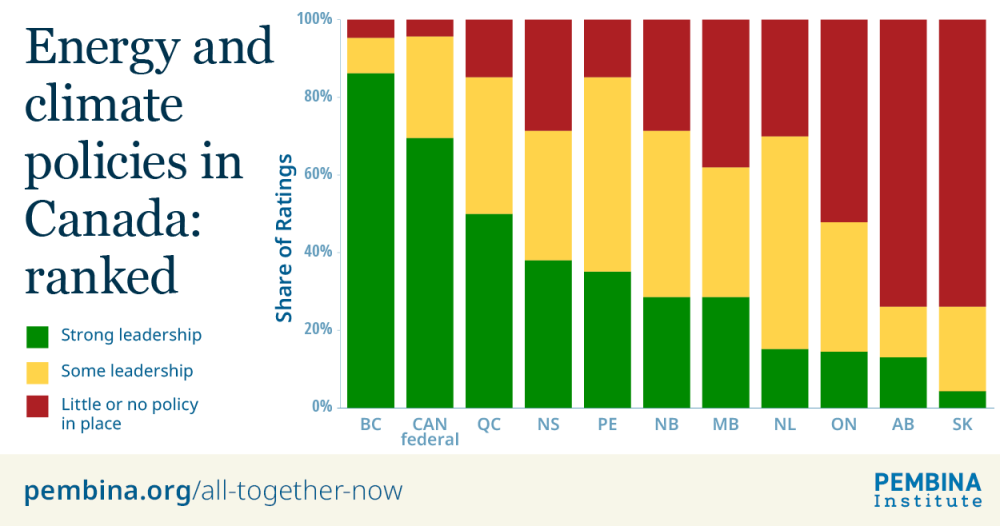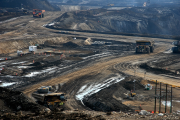Let’s start with some good news: Canada’s climate policies are starting to pay off. That is what our new report concludes based on the latest emissions data. If Canada’s governments stay the course on all the measures that have already been either implemented or announced, we’re on track to significantly reduce emissions this decade, and will get very close to our international commitment of a 40-45 per cent reduction from 2005 levels by 2030.
Who deserves the credit for this? Researchers at our two organizations have just completed a comprehensive evaluation of the state of climate action across Canada, identifying 23 policy indicators that represent best practices in climate governance to assess how the federal and every provincial government is performing. We looked at things like whether or not a government has a net-zero target enshrined in law, and the existence of independent accountability mechanisms to ensure it delivers on that and other interim emissions reduction targets. We also examined policies for specific high-emitting sectors, such as revisions to building codes to create carbon-neutral homes, plans to decarbonize electricity generation by 2035, and measures to increase uptake of zero-emissions vehicles such as sales incentives and investments in supporting infrastructure.
Based on these metrics, the federal government and some provinces—especially British Columbia and Quebec—are showing very promising leadership. Others—like Alberta and Saskatchewan—are falling ever further behind, lacking comprehensive plans of their own and, in many cases, still actively opposing federal measures aimed at reducing emissions. The majority fall somewhere in between, with some bright spots of progress accompanied by some gaps. Prince Edward Island, for example, has the most ambitious climate target—net-zero by 2040, a decade earlier than Canada’s international commitment—yet lacks measures to ensure the sales of zero-emission vehicles. Nova Scotia and New Brunswick both have legislative requirements to prepare climate plans, set emissions reduction targets, and monitor and report back on their progress—but both are falling behind several other provinces on plans to decarbonize their electricity grids by 2035.
Taking stock of this matters, and not only because meeting Canada’s emissions reduction commitments should be a whole team effort. It is also because governments that don’t step up to the plate on climate and energy planning are putting their citizens at risk of being left behind economically as the rest of the world accelerates its transition to low-carbon models of growth. Our message is simple: refusing to implement climate policies will not stop the energy transition from reaching every corner of Canada, but proactively reducing emissions and encouraging the expansion of clean growth industries will serve every province better in the long run. That includes—perhaps especially—provinces that as of now are still largely dependent on carbon-intensive industries, either as drivers of prosperity (in the case of Alberta and its oilsands), or to power the rest of its economy (in the case of Saskatchewan, which remains reluctant to commit to phasing out coal-fired electricity generation).
It’s also important to remember that the energy transition and climate change will have a varied impact on different communities, and left unchecked, the outcomes are likely to be inequitable. That’s why we scored governments on measures they have implemented to protect their citizens from the worst impacts of climate change, as well as steps they are taking to prepare industries and workers through support and retraining. We also looked for evidence of reconciliation being built into climate and energy planning, so that the rights of Indigenous Peoples are being considered and respected from the outset.
On July 10, Canada’s 14 environment ministers from the federal, provincial, and territorial governments will hold their annual meeting, this year in St. John’s, N.L. Our report shows that every government has something to learn—and something to teach—about ways to achieve our long-term goal of net-zero by 2050. In 2024, all Canadians deserve governments that are willing to confront the need to reduce emissions and create a climate-safe, equitable, and prosperous future.
Sarah McBain is a senior analyst at the Pembina Institute. Dr. Thomas Gunton is a professor in the resource and environmental planning program at Simon Fraser University, and a former B.C. deputy minister of environment.








